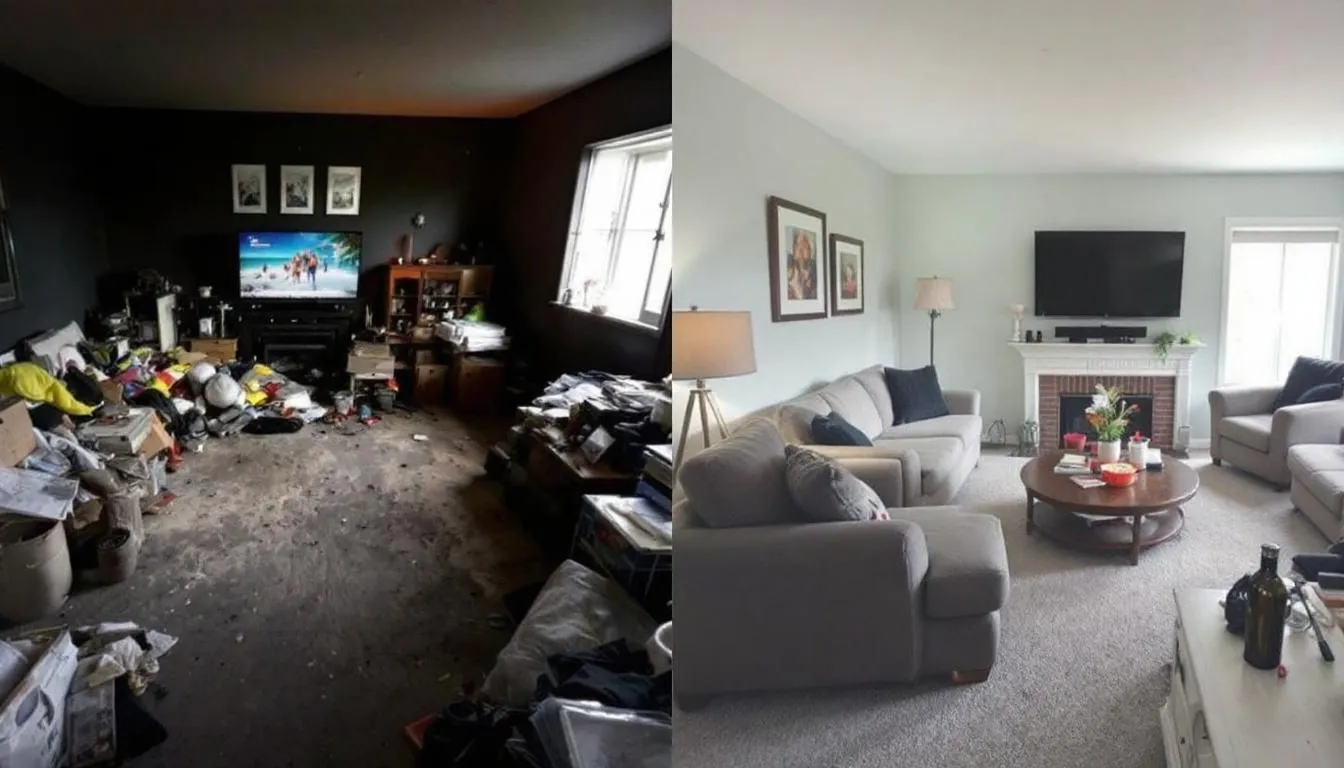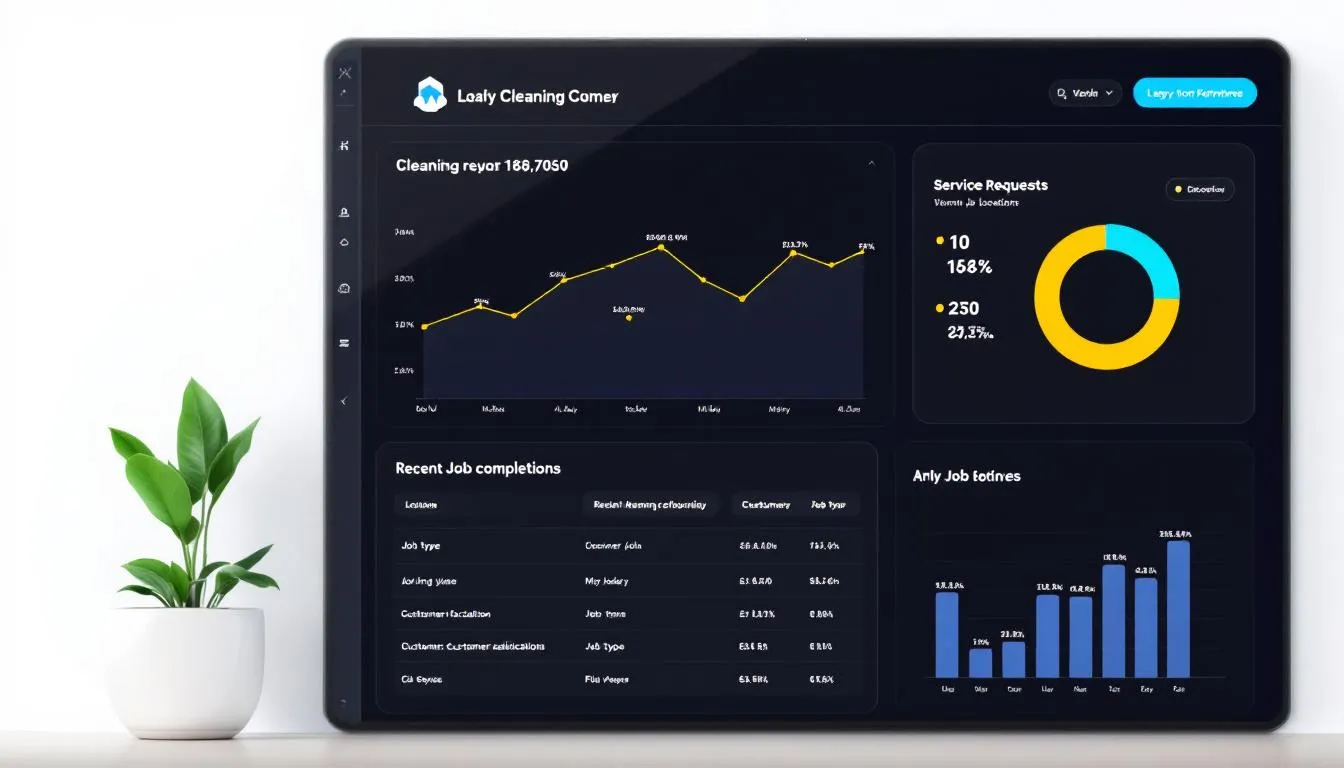Key Takeaways
- Successful cleaning service marketing requires a multi-channel approach combining digital presence with traditional local tactics
- Building a strong brand foundation and defining your target market are essential before implementing any marketing campaigns
- Local SEO and Google Business Profile optimization can drive 70% of your initial customer inquiries without paid advertising
- Customer referrals and reviews generate the highest quality leads with conversion rates 3-5x higher than cold prospects
- Consistent marketing efforts during busy periods prevent revenue gaps and ensure steady business growth year-round
In 2025, over 73% of cleaning service customers discover their providers through digital channels, yet many cleaning business owners still rely primarily on word-of-mouth marketing. While the cleaning industry generates more than $78 billion annually in North America alone, most cleaning businesses struggle to capture their fair share due to ineffective marketing strategies.
The landscape has fundamentally shifted. Digital marketing channels now drive over 50% of all new client inquiries for cleaning services, with SEO-generated leads converting at 14.6% compared to just 1.7% for traditional outbound tactics like cold calling. However, success requires more than just having a website—it demands a comprehensive marketing strategy that combines digital innovation with proven traditional methods.
This guide reveals 12 proven cleaning services marketing strategies that successful cleaning companies use to consistently attract new clients, retain existing customers, and build sustainable growth. Whether you’re launching a new cleaning business or looking to scale an existing operation, these data-driven approaches will help you develop a clear marketing strategy that delivers measurable results.

Building Your Marketing Foundation
Before launching any marketing campaigns, successful cleaning businesses establish a solid foundation that guides all their marketing efforts. This foundation determines how potential clients perceive your cleaning service and whether they choose you over competitors.
Understanding Your Target Market
The most effective cleaning business marketing starts with identifying your ideal customers. Rather than trying to serve everyone, profitable cleaning companies focus on specific market segments that align with their capabilities and pricing structure.
Residential Market Segments:
- Busy professionals earning $50,000+ annually who value time over money
- Families with young children needing regular house cleaning and deep cleaning services
- Senior citizens requiring assistance with maintaining their homes
- Real estate investors needing move-in/move-out cleaning for rental properties
Commercial Market Opportunities:
- Small to medium businesses seeking reliable office cleaning services
- Medical and dental practices requiring specialized disinfection protocols
- Retail establishments needing window cleaning and general maintenance
- Property management companies overseeing multiple commercial properties
Research your local demographics to understand income levels, age distributions, and household compositions within your service area. This data helps you craft targeted messages that resonate with prospective clients and choose the most effective marketing channels for reaching your target audience.
Analyze your competitors’ pricing and service offerings to identify market gaps. For example, if most local cleaning services focus on basic house cleaning, you might differentiate by specializing in green cleaning products or post-construction cleanup services.
Developing Your Brand Identity
Professional branding distinguishes your cleaning business from the crowded market of competitors. Your brand identity encompasses more than just a logo—it communicates your values, reliability, and the quality experience customers can expect.
Visual Brand Elements:
- Choose colors that convey cleanliness and trustworthiness (blues, whites, greens work well for cleaning companies)
- Design a memorable logo that works across all marketing materials, from business cards to vehicle wraps
- Develop consistent typography and imagery styles for your cleaning business website and social media platforms
- Create professional uniforms that reinforce your brand when teams work in customers’ homes or offices
Brand Messaging Framework:
- Craft a compelling tagline that communicates your unique selling proposition in under 10 words
- Develop key messages that address common customer pain points like reliability, thoroughness, and trustworthiness
- Create a brand voice that matches your target market’s communication preferences
- Establish brand standards that ensure consistency across all customer touchpoints
Your brand identity should reflect the professionalism and attention to detail that customers expect from their cleaning service. This consistency builds trust and makes your business more memorable when potential customers are ready to book services.
Digital Marketing Strategies
Digital marketing forms the backbone of modern cleaning services business growth. These strategies help you reach customers actively searching for cleaning services while building long-term relationships with your target audience.
Website Optimization and Local SEO
Your cleaning business website serves as your digital storefront, often providing the first impression potential clients have of your services. A well-optimized website that ranks highly in search engines can generate consistent leads without ongoing advertising costs.
Essential Website Elements:
- Clear navigation with separate pages for residential cleaning, commercial cleaning, and specialty services
- Prominent contact information and online booking system on every page
- Customer testimonials and before/after photo galleries showcasing your work quality
- Detailed service descriptions that include pricing information or ranges
- Mobile-responsive design that loads quickly on all devices
Local SEO Implementation:
- Include location-specific keywords throughout your site content (e.g., “house cleaning services in [city name]”)
- Create location-based landing pages if you serve multiple cities or neighborhoods
- Optimize page titles and meta descriptions with relevant cleaning industry terms
- Add schema markup to help search engines understand your business information
- Build citations on local directories like Yelp, Angi, and Yellow Pages
Focus on creating content that answers common customer questions about cleaning services. This approach improves your search engine rankings while establishing your expertise. For example, write blog posts about “How Often Should You Deep Clean Your Home?” or “What to Expect During Your First Professional Cleaning.” If you’re planning to launch your own cleaning business, you may also want to explore over 300 creative cleaning business names to inspire your brand.
Monitor your website performance using Google Analytics and Google Search Console to track which pages generate the most leads and identify opportunities for improvement.
Google Business Profile Optimization
Your Google Business Profile (formerly Google My Business) often appears at the top of search results when people look for cleaning services in your area. Optimizing this free tool can drive significant organic traffic to your business.
Profile Optimization Strategies:
- Complete every section of your profile with accurate business information
- Upload high-quality photos showing your team at work, before/after results, and your equipment
- Select appropriate business categories (house cleaning service, commercial cleaning, janitorial services)
- Add detailed service descriptions and coverage areas
- Post weekly updates about special offers, cleaning tips, or company news
Review Management:
- Respond to all reviews within 24-48 hours, both positive and negative
- Thank customers for positive reviews and address concerns mentioned in negative feedback
- Encourage satisfied customers to leave reviews through follow-up emails or text messages
- Use review responses to demonstrate your professionalism and commitment to customer satisfaction
Regular posting on your Google Business Profile keeps your listing active and provides fresh content for potential clients. Share cleaning tips, announce seasonal promotions, or highlight recent customer success stories to maintain engagement.

Social Media Marketing
Social media platforms allow cleaning businesses to showcase their work visually while building relationships within their local community. The key is choosing the right platforms and consistently sharing valuable content.
Platform Selection:
- Facebook: Best for reaching homeowners aged 25-55 and joining local community groups
- Instagram: Ideal for sharing before/after photos and behind-the-scenes content
- LinkedIn: Essential for commercial cleaning businesses targeting office managers and property managers
- Nextdoor: Perfect for neighborhood-based marketing and generating referrals
Content Strategy:
- Share transformation photos (with client permission) to demonstrate your cleaning capabilities
- Create short video tutorials showing quick cleaning tips or demonstrating your thoroughness
- Post customer testimonials and reviews to build social proof
- Share team member spotlights to humanize your brand and build trust
- Announce special offers and seasonal promotions
For more ideas and in-depth approaches to online marketing, check out these digital strategies for cleaning businesses.
Community Engagement:
- Join local Facebook groups and community forums where your target customers gather
- Participate in neighborhood discussions by offering helpful cleaning advice
- Share and comment on posts from complementary local businesses like real estate agents
- Respond promptly to comments and direct messages to maintain engagement
Track your social media performance using platform analytics to identify which types of content generate the most engagement and lead to actual inquiries.
Pay-Per-Click Advertising
Paid advertising provides immediate visibility in search results and social media feeds, allowing you to reach customers who are actively looking for cleaning services. Start with a focused approach and scale based on performance.
Google Ads Strategy:
- Target location-specific keywords like “cleaning services near me” and “[city] house cleaning”
- Create separate ad groups for residential and commercial cleaning services
- Write compelling ad copy highlighting unique selling points like “same-day service” or “eco-friendly products”
- Use ad extensions to include your phone number, location, and additional service links
- Set geographic targeting to a 15-20 mile radius around your service area
Facebook and Instagram Ads:
- Target homeowners aged 25-55 in specific zip codes within your service area
- Use lookalike audiences based on your existing customer data
- Create video ads showcasing before/after transformations
- Test different offers like “20% off first cleaning” vs. “free oven cleaning with service”
- Retarget website visitors who haven’t booked services yet
Budget Management:
- Start with $300-500 monthly budget split between Google and Facebook ads
- Monitor cost per lead and adjust bids based on performance
- Pause underperforming ads and increase budget for successful campaigns
- Track conversion rates from ad clicks to actual bookings
Use unique phone numbers or landing pages for each ad campaign to accurately measure which channels provide the best return on investment.
Traditional Marketing Approaches
While digital marketing dominates modern customer acquisition, traditional marketing methods remain effective for cleaning businesses, especially when targeting local customers and building community relationships.
Direct Mail and Print Marketing
Direct mail campaigns can effectively reach homeowners in specific neighborhoods, particularly when timed with seasonal cleaning needs or local events.
Campaign Development:
- Design eye-catching postcards featuring special offers for new customers
- Include clear calls-to-action with QR codes linking to online booking systems
- Target households with income levels above $50,000 in neighborhoods within your service area
- Test different offers like percentage discounts vs. free additional services
- Include customer testimonials and certifications to build credibility
Timing and Targeting:
- Mail during spring cleaning season (March-May) when homeowners are most motivated
- Target before major holidays when people want their homes to look perfect
- Focus on neighborhoods where you already have satisfied customers who can provide referrals
- Mail to new residents who may need move-in cleaning services
- Consider seasonal timing like back-to-school periods when families resume regular routines
Door Hangers and Flyers:
- Design professional materials that don’t look like spam
- Target upscale neighborhoods during weekday mornings when decision-makers are home
- Include limited-time offers to create urgency
- Leave materials in secure, visible locations that won’t blow away
- Track response rates by using unique promo codes for each distribution area
Measuring Results:
- Use unique phone numbers or promo codes to track responses from each campaign
- Calculate cost per lead and conversion rates for different neighborhoods
- Monitor long-term customer lifetime value from direct mail acquired customers
- A/B test different offers, designs, and messaging to optimize performance
Local Networking and Partnerships
Building relationships with other local businesses and community organizations can generate high-quality referrals while establishing your cleaning company as a trusted community member.
Strategic Partnerships:
- Real Estate Agents: Offer move-in/move-out cleaning services for their clients
- Property Managers: Provide regular cleaning services for rental properties and common areas
- Interior Designers: Partner to offer cleaning services before photo shoots or client meetings
- Senior Living Communities: Provide specialized cleaning services for elderly residents
- Childcare Centers: Offer deep cleaning and disinfection services
Community Involvement:
- Join your local chamber of commerce and attend monthly networking events
- Sponsor local sports teams or community events to increase brand visibility
- Volunteer your cleaning services for charity events or fundraisers
- Participate in home and garden shows to demonstrate your expertise
- Host educational workshops about cleaning best practices for homeowners
Professional Networking:
- Attend business networking groups like BNI (Business Network International)
- Join trade associations for cleaning professionals to stay current on industry trends
- Participate in local business mastermind groups
- Connect with other service providers who serve similar customer bases
- Build relationships with suppliers who can refer customers to your business
Partnership Development:
- Create referral agreements with complementary businesses like carpet cleaners or pest control services
- Offer reciprocal referrals to businesses that serve your target market
- Develop co-marketing opportunities like joint promotions or shared booth space at events
- Create partnerships with businesses that can provide regular commercial cleaning contracts
- Establish relationships with insurance companies that recommend cleaning services after claims

Customer Acquisition Strategies
Effective customer acquisition requires strategic promotional offers and systematic follow-up processes that convert inquiries into paying customers while building long-term relationships.
Promotional Strategies
Well-designed promotions attract new customers without devaluing your services or setting unrealistic price expectations for ongoing work.
Seasonal Promotions:
- Spring Deep Clean Packages: Offer comprehensive cleaning services targeting post-winter home refreshing needs
- Holiday Preparation Specials: Create packages for Thanksgiving and Christmas preparation periods
- Back-to-School Cleaning: Target families wanting fresh starts as children return to school
- Move-In/Move-Out Services: Partner with real estate agents to offer specialized cleaning for property transitions
Service Bundling:
- Combine regular house cleaning with carpet cleaning for comprehensive value
- Package window cleaning with exterior pressure washing services
- Offer organizational services alongside deep cleaning for maximum impact
- Bundle multiple rooms or services at discounted rates to increase transaction value
First-Time Customer Incentives:
- Offer 20% discount on initial cleaning to reduce barriers to trying your service
- Provide free add-on services like interior oven cleaning or refrigerator cleaning
- Create “trial packages” at reduced rates for customers to experience your quality
- Offer satisfaction guarantees that remove risk for hesitant prospects
Urgency and Scarcity Tactics:
- Limit promotions to first 20 customers each month to create urgency
- Offer early-bird discounts for customers who book within 48 hours
- Create seasonal deadlines tied to holidays or events
- Provide bonus services for customers who book within specific time frames
Value-Added Offers:
- Include free estimates or home assessments with service bookings
- Provide cleaning supply recommendations or eco-friendly product information
- Offer maintenance tips and schedules to extend time between cleanings
- Create loyalty programs that reward frequent customers with exclusive benefits
Track the performance of each promotional strategy to identify which offers generate the highest quality customers and best long-term retention rates.
Customer Retention and Referral Programs
Retaining existing customers costs significantly less than acquiring new ones, while satisfied customers become powerful advocates for your cleaning business through word-of-mouth marketing.
Referral Program Implementation
A structured referral program can generate 20-30% of new business for cleaning companies while rewarding loyal customers for their advocacy.
Program Structure:
- Offer existing customers $25-50 credit for each successful referral that completes their first cleaning
- Provide referred customers with 15-20% discount on their first three services
- Create physical referral cards that customers can easily share with friends and neighbors
- Implement digital referral tracking through your customer management system
- Send quarterly referral program reminders via email to keep the program top-of-mind
Program Promotion:
- Announce the referral program to existing clients during service visits
- Include referral information in post-service follow-up emails
- Add referral program details to your cleaning business website and social media platforms
- Train team members to mention the program when customers express satisfaction
- Create referral program materials to leave at customer locations
Tracking and Management:
- Use customer relationship management (CRM) software to track referral sources
- Monitor which customers generate the most referrals to identify your best advocates
- Analyze referral conversion rates to optimize program incentives
- Track customer lifetime value for referred customers vs. other acquisition channels
- Adjust rewards based on program performance and customer feedback
Recognition and Rewards:
- Publicly thank customers who provide referrals (with permission) on social media
- Send handwritten thank-you notes for referrals
- Offer tiered rewards for customers who refer multiple new clients
- Create exclusive benefits for your most active referral providers
- Celebrate referral milestones with special recognition or bonuses
Review and Reputation Management
Online reviews significantly influence potential customers’ decisions, with 93% of consumers reading reviews before choosing service providers.
Review Generation:
- Send automated review requests 24-48 hours after service completion
- Include links to multiple review platforms (Google, Yelp, Facebook) for customer convenience
- Train team members to verbally request reviews when customers express satisfaction
- Create easy-to-follow instructions for customers unfamiliar with online review process
- Offer small incentives for customers who leave detailed, helpful reviews
Response Strategy:
- Respond to all reviews within 24-48 hours to demonstrate responsiveness
- Thank customers for positive reviews and highlight specific services mentioned
- Address negative reviews professionally with solutions and invitations for private discussion
- Use review responses to showcase your customer service commitment to potential clients
- Include keywords relevant to your cleaning services in review responses for SEO benefits
Reputation Monitoring:
- Set up Google Alerts for your business name and common misspellings
- Monitor review platforms regularly for new feedback
- Track review trends to identify recurring issues or popular services
- Use review feedback to improve service delivery and training
- Create case studies from exceptional customer experiences for marketing materials
Review Utilization:
- Feature positive reviews prominently on your website homepage
- Share customer testimonials on social media platforms
- Include review excerpts in marketing materials and proposals
- Create video testimonials from willing customers for maximum impact
- Use review insights to refine service offerings and customer communication

Content Marketing and Video Strategies
Content marketing establishes your cleaning business as an expert resource while improving search engine rankings and attracting organic traffic from potential customers seeking cleaning advice.
Educational Content Development
Creating valuable content that helps your target audience solve common cleaning challenges positions your business as a trusted authority while attracting potential clients through search engines.
Blog Content Topics:
- Seasonal cleaning checklists for spring, fall, and holiday preparation
- Stain removal guides for common household accidents
- Deep cleaning vs. regular cleaning: what homeowners need to know
- Eco-friendly cleaning alternatives for health-conscious families
- Maintenance tips to keep homes cleaner between professional services
Content Distribution:
- Publish weekly blog posts on your cleaning business website
- Share content excerpts on social media platforms with links to full articles
- Create downloadable guides and checklists for email newsletter subscribers
- Repurpose blog content into social media posts and quick cleaning tips
- Submit helpful articles to local community newsletters and websites
SEO Benefits:
- Target long-tail keywords like “how to remove pet stains from carpet”
- Create location-specific content like “spring cleaning checklist for [city] homes”
- Build authority with comprehensive guides that attract backlinks from other websites
- Improve local search rankings with location-based cleaning advice
- Generate organic traffic from people searching for cleaning solutions
Video Marketing Tactics
Video content receives higher engagement rates than text-based content and allows potential customers to see your team’s professionalism and attention to detail.
Video Content Types:
- Before/After Transformations: Create 60-90 second videos showing dramatic cleaning results
- Quick Cleaning Tips: Share practical advice in 30-60 second instructional videos
- Behind-the-Scenes Content: Show your team’s professionalism and systematic approach
- Customer Testimonials: Film satisfied customers describing their experience with your service
- Team Introductions: Help potential customers feel comfortable with the people entering their homes
Production and Distribution:
- Use smartphones with good lighting rather than expensive equipment for authentic feel
- Create consistent branding with intro graphics and company colors
- Share videos across multiple platforms: YouTube, Facebook, Instagram, and TikTok
- Optimize video titles and descriptions with relevant cleaning industry keywords
- Create playlists for different topics like “Cleaning Tips,” “Customer Stories,” and “Our Team”
Video SEO:
Looking to expand your cleaning business? Check out 37 profitable cleaning services you can offer to maximize your earnings.
- Include relevant keywords in video titles and descriptions
- Add closed captions to improve accessibility and search rankings
- Create compelling thumbnails that encourage clicks
- Use video content to improve website dwell time and engagement
- Embed videos on relevant blog posts and service pages
Performance Tracking:
- Monitor view counts, engagement rates, and conversion metrics
- Track which videos generate the most website traffic and inquiries
- Use analytics to identify optimal posting times and content types
- A/B test different video styles and topics to optimize performance
- Measure the impact of video content on overall marketing goals
Measuring Success and ROI
Effective marketing requires consistent measurement and optimization based on performance data. Understanding which strategies generate the best return on investment allows you to allocate marketing budget efficiently and scale successful tactics.
Key Performance Indicators
Track specific metrics for each marketing channel to identify the most effective strategies for your cleaning services business.
Lead Generation Metrics:
- Cost per Lead: Calculate how much you spend to generate each inquiry across different channels
- Lead Quality Score: Rate leads based on their likelihood to convert into paying customers
- Source Attribution: Track which marketing channels generate the most qualified prospects
- Monthly Lead Volume: Monitor lead generation trends to identify seasonal patterns
- Geographic Distribution: Analyze which service areas generate the most inquiries
Conversion Metrics:
- Inquiry to Appointment Rate: Percentage of inquiries that result in scheduled estimates or services
- Estimate to Sale Conversion: Track how many estimates convert to actual cleaning contracts
- Average Sale Value: Monitor transaction sizes across different customer segments
- Time to Conversion: Measure how long it takes leads to become paying customers
- Service Upgrade Rate: Track how often customers add additional services
Customer Retention Metrics:
- Customer Lifetime Value: Calculate total revenue from average customer relationships
- Retention Rate: Percentage of customers who continue using your services after initial cleaning
- Repeat Business Frequency: How often customers book recurring or additional services
- Churn Rate: Percentage of customers who stop using your services
- Referral Rate: How often existing customers refer new business
Financial Performance:
- Revenue per Marketing Channel: Track which strategies generate the most income
- Return on Marketing Investment: Calculate ROI for each marketing tactic
- Customer Acquisition Cost: Total cost to acquire each new customer
- Marketing Budget Efficiency: Percentage of marketing spend that generates positive ROI
- Monthly Recurring Revenue: Track subscription-based or regular cleaning service income
Analytics Tools and Tracking
Implement systems that provide accurate data about your marketing performance and customer behavior.
Digital Tracking: Using a customer referral program is a strategic way to leverage digital tracking for monitoring referred leads and overall success.
- Google Analytics: Monitor website traffic, user behavior, and conversion paths
- Google Search Console: Track search engine rankings and organic traffic performance
- Call Tracking Software: Use unique phone numbers to identify which marketing generates calls
- CRM Systems: Manage customer data and track sales pipeline progression
- Social Media Analytics: Monitor engagement rates and social media-driven traffic
Attribution Methods:
- Ask new customers how they found your business during initial conversations
- Use unique promotional codes for different marketing campaigns
- Implement UTM parameters for digital marketing links to track traffic sources
- Create dedicated landing pages for specific campaigns to measure effectiveness
- Track referral sources systematically through customer intake processes
Reporting and Analysis:
- Create monthly marketing reports that summarize performance across all channels
- Identify trends and patterns in customer acquisition and retention
- Compare year-over-year performance to track business growth
- Calculate return on investment for each marketing strategy
- Use data insights to optimize budget allocation and campaign performance
Optimization Strategies:
- Pause or reduce spending on underperforming marketing channels
- Increase investment in high-performing strategies
- Test new variations of successful campaigns
- Adjust messaging based on customer feedback and conversion data
- Continuously refine targeting parameters for paid advertising campaigns

Frequently Asked Questions
What’s the most cost-effective marketing strategy for new cleaning businesses?
Google Business Profile optimization and local SEO provide the highest ROI for new cleaning businesses, often generating 60-80% of initial inquiries at minimal cost. Start by claiming and completely filling out your Google Business Profile, then focus on collecting your first 10-15 customer reviews. Combine this with targeted door hangers in neighborhoods where your ideal customers live. This approach typically costs under $500 initially but can generate consistent leads for months. Avoid expensive paid advertising until you have optimized these free or low-cost channels first.
How much should I budget for marketing my cleaning service?
Most successful cleaning businesses allocate 8-12% of gross revenue to marketing efforts, with new businesses investing 15-20% during the first year to establish market presence. For a cleaning service generating $10,000 monthly revenue, this translates to $800-1,200 in monthly marketing spend. Prioritize digital channels that provide measurable results: 40% for website and SEO, 30% for paid advertising (Google Ads and social media ads), 20% for traditional marketing like direct mail, and 10% for networking and community events. Track ROI monthly and adjust allocation based on which channels generate the most qualified leads.
How long does it take to see results from different cleaning service marketing strategies?
Marketing timeline expectations vary significantly by channel. Google Ads can generate immediate visibility and leads within 24-48 hours of launching campaigns. Local SEO typically takes 3-6 months to achieve significant organic traffic improvements, but provides long-term benefits. Social media marketing shows engagement within weeks, but lead generation usually takes 2-3 months of consistent posting. Direct mail campaigns typically generate responses within 2-3 weeks of distribution. Referral programs often produce results within 30 days once implemented with existing satisfied customers. Email marketing to existing customers can generate immediate responses for promotional offers.
Should I focus on residential or commercial cleaning marketing?
The choice depends on your business goals, resources, and local market conditions. Residential cleaning typically offers more frequent service opportunities with higher customer lifetime value, but requires extensive local marketing and customer service capabilities. Commercial cleaning provides larger contracts with steady monthly revenue, but demands longer sales cycles, professional presentations, and sometimes specialized equipment or certifications. Many successful cleaning companies start with residential services to build cash flow and customer testimonials, then gradually expand into commercial markets. Consider your competition levels in each sector and your team’s capabilities when making this decision.
What common marketing mistakes should cleaning business owners avoid?
Avoid competing solely on price, as this attracts price-sensitive customers who rarely become loyal, profitable clients. Don’t neglect online review management—failing to respond to negative reviews promptly can severely damage your reputation. Never discontinue marketing efforts during busy periods, as this creates revenue gaps during slower seasons. Avoid inconsistent branding across marketing materials, which confuses potential customers and reduces professional credibility. Don’t try to be everywhere at once; focus on 2-3 marketing channels initially and master them before expanding. Finally, avoid launching marketing campaigns without proper tracking systems to measure results and ROI.